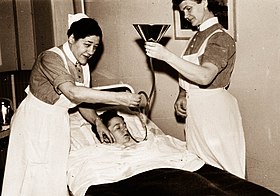
Back معالجة بالصدمة الإنسولينية Arabic Terapia de choque con insulina AST Insulinschocktherapie German Terapia de choque con insulina Spanish Insuliinišokkihoito Finnish Cure de Sakel French インスリン・ショック療法 Japanese Insulīna šoka terapija Latvian/Lettish Leczenie wstrząsami insulinowymi Polish Инсулинокоматозная терапия Russian
| Insulin shock therapy | |
|---|---|
 Insulin shock therapy administered in Långbro Hospital, Stockholm in the 1930s | |
| ICD-9-CM | 94.24 |
| MeSH | D003295 |
Insulin shock therapy or insulin coma therapy was a form of psychiatric ‘‘treatment’’ in which patients were repeatedly injected with large doses of insulin in order to produce daily comas over several weeks.[1] It was introduced in 1927 by Austrian-American psychiatrist Manfred Sakel and used extensively in the 1940s and 1950s, mainly for schizophrenia, before falling out of favour and being replaced by neuroleptic drugs in the 1960s.[2]
It was one of a number of physical treatments introduced into psychiatry in the first four decades of the 20th century. These included the convulsive therapies (cardiazol/metrazol therapy and electroconvulsive therapy), deep sleep therapy, and psychosurgery. Insulin coma therapy and the convulsive therapies are collectively known as the shock therapies.
- ^ Neustatter WL (1948) Modern psychiatry in practice. London: 224.
- ^ Jones, K (2000). "Insulin coma therapy in schizophrenia" (PDF). Journal of the Royal Society of Medicine. 93 (3): 147–149. doi:10.1177/014107680009300313. PMC 1297956. PMID 10741319. Archived from the original (PDF) on 20 February 2009.